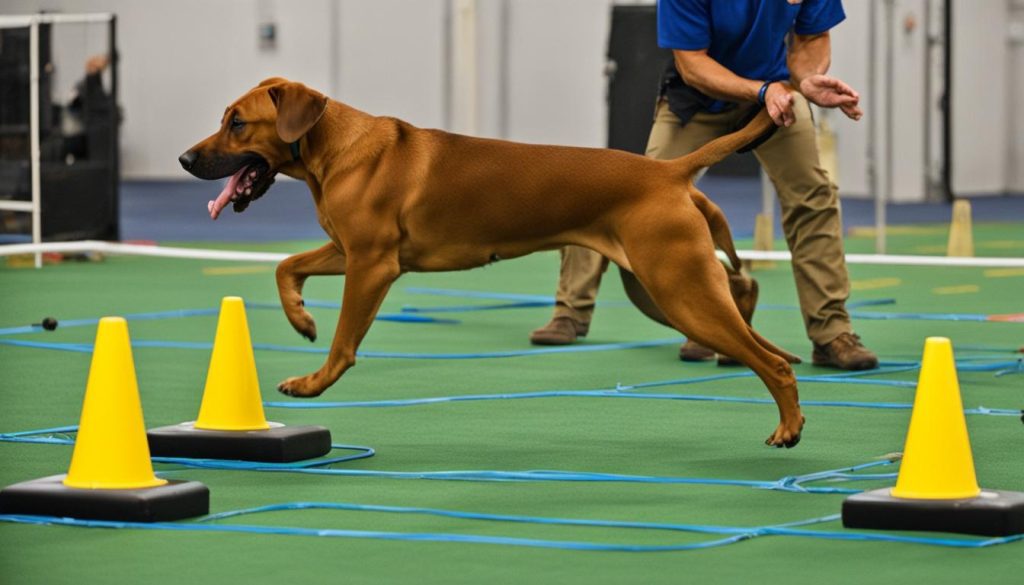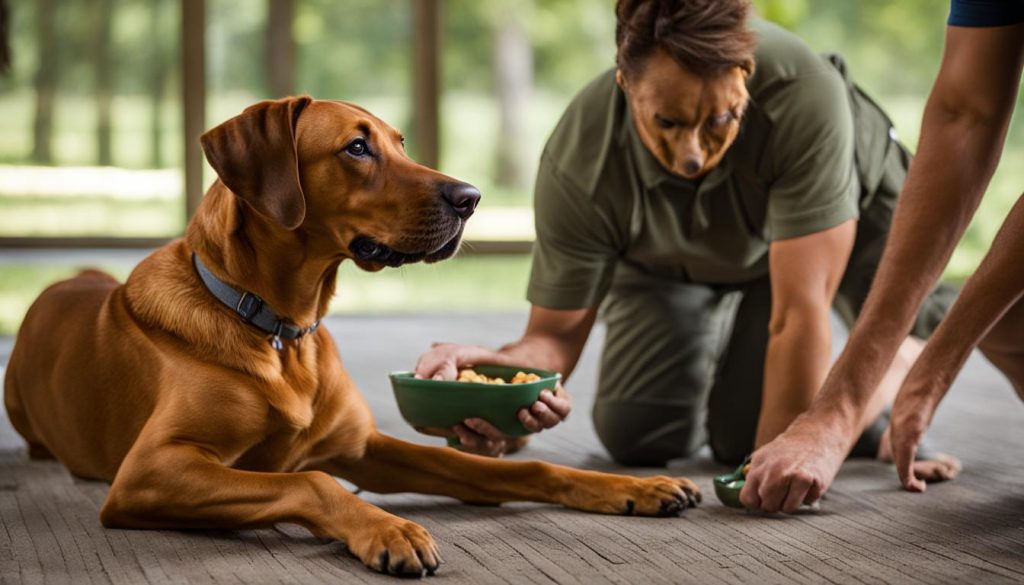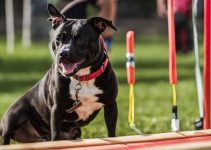Welcome to my article on Rhodesian Ridgeback training! As an experienced dog trainer, I understand the unique challenges that come with training these majestic and intelligent dogs. Rhodesian Ridgebacks are known for their independent nature and strong will, which can make training a bit more challenging compared to other breeds. However, with the right techniques and a consistent approach, you can turn your Ridgeback into a well-behaved and obedient companion.
In this article, I will share valuable training tips and techniques for Rhodesian Ridgebacks, from basic obedience commands to advanced training methods. By focusing on positive reinforcement and using consistent Rhodesian Ridgeback training methods, you can establish a strong bond with your Ridgeback and help them thrive in any situation.
Rhodesian Ridgeback Training
- Start training your Rhodesian Ridgeback early and be consistent in your approach.
- Utilize positive reinforcement, such as treats, praise, and playtime, to encourage desired behaviors.
- Keep Rhodesian Ridgeback training sessions short and engaging to maintain your Ridgeback’s focus.
- Learn to understand your Ridgeback’s body language to better communicate and address their needs.
- Patience is key – avoid punishment-based training methods and celebrate small milestones along the way.
The Importance of Early Training and Consistency
Starting training early is crucial for Rhodesian Ridgebacks. As a responsible pet owner, I understand that laying a foundation for obedience and good behavior is essential from the start. By introducing basic commands like sit, stay, and come, you can establish a line of communication with your Ridgeback. Remember that training is a continuous process, and it’s important to gradually introduce more advanced techniques to keep your dog mentally stimulated.
Consistency plays a vital role in successful Rhodesian Ridgeback training. Using the same commands and rewards throughout the household will help your Ridgeback understand what is expected of them. It’s important for all family members to be on the same page and follow a consistent approach. This consistency will prevent confusion and reinforce the training your Ridgeback receives.
Regular Rhodesian Ridgeback training sessions are key to reinforcing learned behaviors and building upon them. Two to three short sessions each day, lasting around 10-20 minutes, is an effective training routine. During these sessions, incorporate leash training to teach your Ridgeback proper walking etiquette and command training to expand their repertoire of obedience cues.

Using Positive Reinforcement and Short Sessions
When it comes to Rhodesian Ridgeback training, positive reinforcement is a powerful tool. By rewarding good behavior with treats, praise, and playtime, you can motivate your Ridgeback to repeat desired actions. This training technique not only fosters a strong bond between you and your dog but also encourages them to engage in the behaviors you want to reinforce.
One essential aspect of training is keeping your sessions short and focused. A typical training session for a Rhodesian Ridgeback should last around 10-20 minutes. Keeping the sessions short helps maintain your dog’s attention and prevents them from getting bored or distracted. Remember that Ridgebacks are intelligent but can be strong-willed, so maintaining their focus is crucial for effective training.
Additionally, incorporating behavior modification techniques into your training routine can address any unwanted behaviors your Ridgeback may exhibit. Whether it’s jumping, excessive barking, or leash pulling, behavior modification techniques can help reshape these behaviors into more desirable ones. By utilizing positive reinforcement and consistent training techniques, you can effectively modify your Ridgeback’s behavior and promote a harmonious coexistence.
Remember, training should be a positive experience for both you and your dog. Always approach training sessions with patience, consistency, and a calm demeanor. If you encounter any challenges or need additional guidance, consider consulting a professional dog trainer who specializes in behavior modification and positive reinforcement techniques.

Understanding Your Ridgeback’s Body Language
Dogs, including Rhodesian Ridgebacks, communicate through body language. Paying attention to your Ridgeback’s non-verbal cues can help you understand their needs and emotions during Rhodesian Ridgeback training.
Facial expressions, such as a relaxed mouth and soft eyes, indicate a calm and content state. On the other hand, a wrinkled forehead or raised hackles may indicate fear, agitation, or aggression.
Ear and tail positions are also important indicators. A raised tail and perked ears generally suggest alertness or excitement, while a tucked tail and flattened ears may indicate fear or submission.
Furthermore, sounds like barks, growls, whines, or howls can convey a range of emotions and intentions. A deep, rumbling growl may signal aggression, while a high-pitched bark might indicate fear or excitement. It’s essential to pay attention to the context and accompanying body language to accurately interpret these vocalizations.
Properly understanding your Ridgeback’s body language enables you to respond appropriately and tailor your training approach to ensure the best results. It also helps build a stronger bond between you and your dog.
Importance of Crate Training
Crate training is an invaluable component of puppy training. Introducing your Ridgeback to a crate from an early age creates a safe and comfortable space for them, where they can relax and retreat when needed.
When properly utilized, a crate can aid in potty training, prevent destructive behaviors, and ease separation anxiety. It serves as a den-like environment, mimicking a dog’s natural instincts as den-dwelling animals.
Remember, crate training should always be positive and gentle. Gradually acclimate your Ridgeback to the crate by placing treats, toys, and comfortable bedding inside. Never use the crate as a form of punishment, as it should be seen as a positive and secure space for your dog.
Early Socialization for a Well-Adjusted Ridgeback
Early socialization is crucial for any puppy, including Ridgebacks. Exposing your dog to a variety of environments, sounds, people, and other animals during their critical socialization period (between 7 and 16 weeks of age) helps them become confident and well-adjusted adults.
Take your Ridgeback to puppy classes or set up playdates with other friendly, vaccinated dogs to promote positive interactions and proper social behavior. Additionally, introduce your puppy to different types of people, including children, men, women, and individuals wearing hats or uniforms.
A professional dog trainer can provide guidance and puppy training classes to ensure proper socialization. They can also offer valuable insights, techniques, and personalized advice for raising a well-behaved Ridgeback.
Patience and Avoiding Punishment-Based Training
When it comes to ridgeback dog training, patience is key. Rhodesian Ridgebacks are known for their independent nature, which can make training challenging at times. It’s important to remember that training takes time and consistency. Avoid using punishment-based training methods, as they can harm the bond between you and your Ridgeback.
Instead, focus on positive reinforcement techniques. This means rewarding your Ridgeback with treats, praise, and playtime when they exhibit desired behaviors. For example, if your Ridgeback responds well to a command and sits on command, reward them with a treat and enthusiastic praise. This positive reinforcement strengthens the connection between the action and the reward, encouraging your Ridgeback to repeat the behavior.
Consistency in commands is also crucial. Use the same commands consistently throughout Rhodesian Ridgeback training sessions and ensure that everyone in the household is using the same commands and rewards. This helps your Ridgeback understand what is expected of them and avoids confusion.
Training your Rhodesian Ridgeback also requires the investment of time and effort. Celebrate small milestones and progress along the way. Remember that building a trusting relationship with your Ridgeback is crucial, and through positive reinforcement and consistent training, you can achieve effective ridgeback training techniques and a well-behaved companion.
Conclusion
Training a Rhodesian Ridgeback requires dedication, consistency, and patience. By utilizing positive reinforcement techniques, understanding your Ridgeback’s body language, and providing early socialization, you can achieve successful obedience training. However, if you find yourself in need of additional guidance or support, consider enrolling in ridgeback training classes or seeking the assistance of a professional ridgeback training service.
These specialized programs and services are designed to provide you with the necessary knowledge and tools to train your Rhodesian Ridgeback effectively. Whether you are a new owner looking for guidance on basic obedience commands or an experienced handler seeking advanced training techniques, ridgeback training classes can offer invaluable resources and support.
A professional ridgeback training service can also be a great option for personalized training. These services are tailored to meet the specific needs and challenges of your Rhodesian Ridgeback. With the expertise of a professional trainer, you can address any behavioral issues and work towards building a strong bond with your Ridgeback through effective training methods.
FAQ
When should I start training my Rhodesian Ridgeback?
It is crucial to start training your Rhodesian Ridgeback as early as possible. Begin with basic obedience commands and gradually introduce more advanced techniques.
How important is consistency in training my Ridgeback?
Consistency is key in training. Use the same commands and rewards throughout the household to avoid confusion. Regular training sessions incorporating leash training and command training will help establish boundaries and expectations.
What is the most effective training method for Rhodesian Ridgebacks?
Positive reinforcement is highly effective in training Rhodesian Ridgebacks. Rewarding good behavior with treats, praise, and playtime will encourage your Ridgeback to repeat desired actions.
How long should training sessions be for my Ridgeback?
It is recommended to keep training sessions short, typically around 10-20 minutes, to maintain your Ridgeback’s focus and prevent them from becoming bored or distracted.
How can I understand my Ridgeback’s needs and emotions during training?
Dogs, including Rhodesian Ridgebacks, communicate through body language. Paying attention to your Ridgeback’s non-verbal cues, such as facial expressions, ear and tail positions, and sounds, can help you understand their needs and emotions during training.
Is it necessary to seek professional help for training a Ridgeback?
While it is possible to train your Ridgeback on your own, seeking guidance from a professional dog trainer can provide additional support and expertise.
What should I avoid when training my Rhodesian Ridgeback?
It is important to avoid using punishment-based training methods as they can harm the bond between you and your Ridgeback. Instead, focus on positive reinforcement, consistent commands, and rewards to encourage desired behaviors.
How much patience is required when training a Ridgeback?
Patience is essential when training Rhodesian Ridgebacks due to their independent nature. Celebrate small milestones and be prepared to invest time and effort into training to build a trusting relationship with your Ridgeback.






